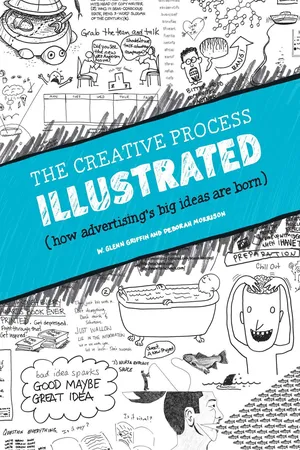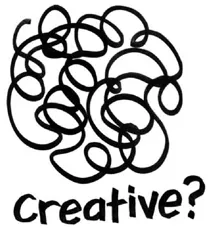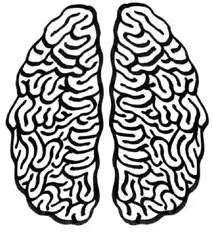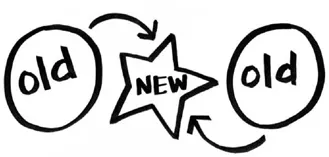![]()
CHAPTER ONE
PROCESS IS PURE
Most people, when they see an ad, never think about how it came to be. In fact, people don't consciously engage with most advertising, period. It's noise. It's part of the landscape. It blends in. And for the same reason you're unlikely to notice any particular tree during a walk through a neighborhood park, you probably won't pay any attention to a television commercial, billboard, radio spot, web banner or any other branded message unless it's different in some significant way. We've convinced ourselves that we've seen everything before. That makes advertising a very tough business.
Those great ads that do break through — the very best of the lot — are those that do the job for the client (they communicate about the product and satisfy strategic objectives) and also leave consumers happier, wiser… somehow better for having engaged with the ad (they deliver a “gift” in exchange for their attention). When an ad sells and does so with great style, it's a thing of beauty. But when ads simply do one or the other, they fall short of fulfilling their potential. The creative folks that make ads every day strive to find the right balance of the two.
Advertising is a thoroughly collaborative business. Inside ad agencies, teams of professionals who specialize in marketing, research, media, technology, production and creativity (the list can go on, depending on the project) work together to serve the client's needs. It makes sense, then, that just about every ad you see that's selling a big brand is the end product of mammoth interaction — the sum of many edits, revisions, restarts and critiques by many different people. Everyone's got fingerprints on the work.
Within that collaborative machine, creative directors supervise the art directors (the visual people) and writers (the word people) working on a specific account. Typically, one art director and one writer are paired to work together to generate ideas, but creative teams can vary in size (and sometimes specialty) if need be. The creative directors are the more senior and experienced pros who started out in art direction or writing. These days, they guide the work of their own teams, assuring that it meets the agency's standards and (with any luck) the client's, too. The creative ideas they generate get circulated throughout the agency; those determined to be the strongest are shared with the client. The client's evaluation of the work can send it back for revision, push it through to see the light of day as a finished ad or kill it in favor of another approach. (That's a woefully simple summary of how things can happen, but you get the idea.) A great idea can run that gauntlet, but it can seem miraculous whenever it happens.
At the center of all this (and, regrettably, too often overlooked) are the individuals who've invested their big brains in this enterprise. They might have been geneticists or screenwriters or architects or economists or poet laureates, but they chose to make advertising. They'll tell you they do it because they love it, and because they couldn't imagine being happier doing something else. They're creative people, yes… but of a rare breed. They don't create as a means of pure self-expression. Instead, they enjoy the challenge of doing something imaginative/surprising/amazing/smart/beautiful that will meet someone else's specifications and solve their problems. They don't sign their works of art. They labor in anonymity. Think about it: In this business, a writer can pen a phrase on every American's lips (“Can you hear me now?”) but only his mom gives him credit. An art director's colorful vision of dancing silhouettes enjoying the iPod is more ubiquitous than Warhol, but museum curators don't know her name.
We're fascinated by the creative minds that answer the call to be professional creatives. These individuals are at the core of everything that makes advertising interesting. They are true artists in the sense that their work is constantly broadening, enriching and challenging our concept of that term. Each of them brings a unique intellectual perspective to the work they do, and their talent is a hot commodity. Agencies (the good ones, anyway) understand that they have to recruit the best brains available. After all, their piece of a 500 billion dollar industry is at stake.
For that reason, these creatives understand more about their own brains than most of us do. Working in this business, they've honed their own creative process for developing ideas. That personal process, we believe, is representative of advertising creativity in its purest form.
Creative directors, art directors and writers see the mind as an instrument. It's the most important tool they use at work.
Creativity is advertising's most valuable resource. Studying, understanding and appreciating the nature of the creative process, we believe, should be a priority in the scholarly realm; this area of inquiry holds the potential to accentuate advertising's significant contributions to culture and quality of life.
Remarkably, the study of creativity and the creative process is still rather new. This chapter will offer you an overview of research, definitions for some important terms, theoretical insights and a sense of how advertising connects to it all.
WHAT IS CREATIVITY?
In order to study something, it's essential to start with a definition that precisely describes the topic of interest and distinguishes it from others. Historically, that's been one of the major obstacles to the study of creativity. The term “creative” feels very big, and it's often used to describe anything that's new, different, odd or unexpected. Even though it's easy to carelessly throw the term around, “creative” also carries connotations of something special, rare or valuable. It seems intuitive, therefore, that the true definition of the word must be somewhere in the middle.
To complicate matters further, for centuries now, creativity has also been attached to the magical or supernatural. It's been the topic of much romance and fantasy. The classical Greek philosopher Plato (c. 427–c. 347 B.C.) explained that goddesses known as the Muses inspired mankind's artistic creations, attributing no innate creative agency/ability to human beings. Hundreds of years later, the poet Alexander Pope (1688–1744) was celebrating his own Muse and Rudyard Kipling (1865– 1936), author of The Jungle Book, cited a “daemon” that lived in his pen, perpetuating the link between creative works and otherworldly forces.
Over the past century, scholarly research on creativity was confounded by a number of issues. First, and perhaps most significantly, creative thinking isn't a readily observable phenomenon. While we might be able to see ideas or other creative products realized, trying to figure out how or where they originated in the human mind is a different story. So far, science hasn't developed a viable method for watching us think in real time and certainly not at a level of sophistication that can differentiate creative thinking from any other type.
Second, creativity was long considered a peripheral psychological phenomenon, meaning that most experts viewed creative thinking as either a secondary (less significant) cognitive function or one that wasn't commonly experienced by most people. And, as we've already noted, the lack of a clear and concise definition of creativity was a great obstacle in getting studies off the ground.
Creativity as Problem Solving
Despite the fact that the study of creativity remains relatively new, a more rational, focused and practical view of it has begun to emerge. The most widely accepted scholarly definition of the term now frames it as a problem-solving activity. However, not every solution to a problem is necessarily a creative solution.
Harvard University professor Teresa Amabile, in her book The Social Psychology of Creativity, identifies two types of solutions: (a) algorithmic solutions (preexisting, linear series of steps to be followed); and (b) heuristic solutions (new methods developed in the absence of algorithms). Clearly, a “creative” solution would be considered heuristic in nature rather than algorithmic, because it represents a new approach for solving a problem.
In advertising, the challenge to solve a client's problems is ever present. How can people be convinced to drink more milk? What can be said about tires that hasn't already been said? Is there a way to position this personal computer as the hip, youthful alternative to the market leader? Algorithms abound. Formulaic approaches (those tried-and-true templates that clients love) are everywhere. The best art directors and writers will look for a new (heuristic) approach for crafting brand messages in a crowded, copycat category.
Novelty
Novelty, in fact, is another essential element in defining creativity. Case in point: Scholars in the field of aesthetics argue that novelty is a key characteristic for evaluating works of art. Experimental research evidence suggests that creatively productive people prefer novelty, attributable to a characteristic open-mindedness and distaste for the traditional or commonplace in everyday life. It is important to note, however, that the “new” or “novel” can be derived from the old; the creative mind can combine or synthesize existing material to yield new products. Some may suggest that “there's nothing new under the sun,” but creativity defies this perspective by discovering new combinations, connections and relationships.
Agency creatives live in constant fear of becoming hacks. There's great pressure to avoid ripping off (whether by accident or on purpose) someone else's work or producing something that is boring and flat. Of course, it can be hard to discern whether or not an idea for an ad is original when you're so immersed in the business. Luke Sullivan, group creative director at the agency GSD&M and the author of Hey Whipple, Squeeze This: A Guide to Creating Great Ads, suggests that art directors and writers should admire good work that others do but then promptly forget it. Perhaps easier said than done, but wise words nonetheless.
Usefulness
If we think of creativity as a method of problem solving, it's easy to understand how the creativity of an idea could be measured by how useful it is. If we solve a problem, the method used for solving it was beneficial to us. This also introduces the idea that creativity makes a valuable contribution (at some level) in people's lives and isn't purely self-serving. There's a sense that creativity has an inherent social value. Arthur J. Cropley, emeritus professor of psychology at the University of Hamburg, insists that creative ideas must be shared and “accepted or at least tolerated” by society, which he calls “socio-cultural validation.”
No matter how “creative” we might consider an ad or a campaign to be from a variety of other perspectives, its ability to fulfill the client's objectives is key. Many industry award shows reward agencies...



